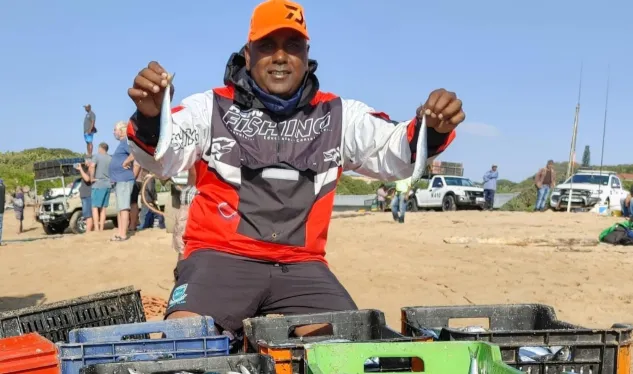Anticipation builds for the 2025 Sardine Run along the KZN coast
Preparations underway

Jayce Govender with sardines he netted during last year's sardine run
Image: Suppllied
IN A FEW weeks, the KZN coastline will be a spectacular hub of activity as the 2025 Sardine Run is expected to create a fishing frenzy.
Seine netters and the KZN Sharks Board have begun preparations for the greatest shoal on earth, with predictions that sardines will arrive in KZN by the second week of June.
Wayne Harrison, the head of operations at the KZN Sharks Board, said while predictions could be tricky, the shores were expected to be filled with silvery cold-water fish.
“We are dealing with nature and at the moment things are looking positive. But things can change in a moment. We can expect sardines in two weeks time, or they can pop up tomorrow, or not pop up at all. But by mid-June, they should be arriving in KZN,” Harrison said.
He said from the reports they were receiving from Transkei three days ago, sardines were spotted passing the Umtata River mouth in the Eastern Cape, and were heading north.
“Activity in the shallow waters is looking positive, but the sardines have not passed through Port St John's as yet. Once the sardines are spotted, we will liaise with local authorities and bathing will be closed due to activity levels from various different marine animals.
“The ocean becomes a hub of activity during the sardine run, with different types of fish, whales, orcas, dolphins and sharks."
The annual sardine run is also a hub of activity for fisherfolk, shark fishermen, and seine netters.
“It is an incredible time for fishing. Netting of the sardines is out of this world to view, and the commercial value to the sardine run, netting and selling sardines, is amazing. It is a mass cash injection that comes into the KZN south coast due to holidaymakers and visitors coming to view the sardine run,” added Harrison.
The KZN Sharks Board have stopped using shark nets during the sardine run, and have changed their system from nets to drum lines.
The drumlines replaced almost 50% of the nets, which were in place, and was introduced to reduce the bycatch of harmless non-shark species such as whales, dolphins and turtles, which are accidently caught in the nets.
Harrison said the drum lines were already in place in anticipation of the whale migration and the annual sardine run, which occurred in winter.
Seine netter, Jayce Govender, said he was also keeping an eye out for sardines, and expected to net his first shoal in the second week of June.
“Currently, there are large shoals offshore from East London to Coffee Bay. We received information that there are lots of birds, gannets, dolphins and shark activity in the area. The sardines are hugging the coastline and are sitting in a pocket of cold water between Waterfall Bluff and Coffee Bay in the Eastern Cape.
“They are waiting for a cold front to push the cooler water into the KZN coastline. This allows sardines to migrate faster as they follow cooler water. The water temperature is currently about 22 degrees off the KZN coastline and sardines will arrive once the temperature drops by a few degrees,” he added.
Govender said cooler water held more plankton and sardines fed on that.
“Next week, we expect swells of up to four metres, which will help the sardines move closer. From June 10, we should start seeing some action on our coastline. Besides sardines, fisherfolk look forward to the shoals of red-eye fish, shad, garrick and mackerel,” added Govender.
He said the economic impact of the sardine run was phenomenal.
“Poor people will catch sardines to sustain themselves, and this is a cheap form of protein. From a commercial point, it improves tourism, as people who visit the KZN coast or follow the shoals during the sardine run will use local accommodation, shops, etc, and boost local economies.
“The sardine run also creates about 3 000 jobs and it is a great economic contributor,” Govender said.